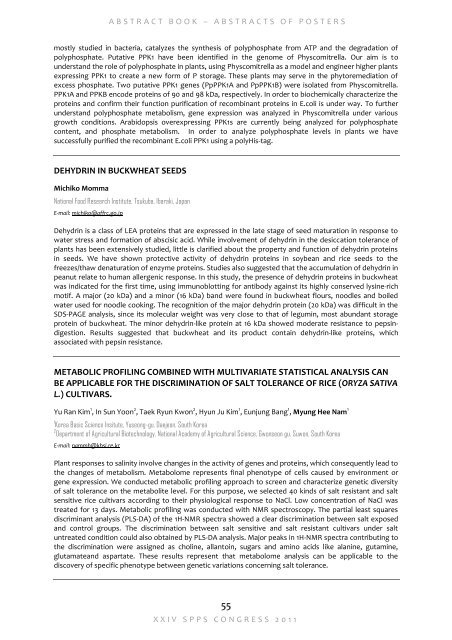1. Front Cover.cdr - CORE
1. Front Cover.cdr - CORE
1. Front Cover.cdr - CORE
You also want an ePaper? Increase the reach of your titles
YUMPU automatically turns print PDFs into web optimized ePapers that Google loves.
A B S T R A C T B O O K – A B S T R A C T S O F P O S T E R S<br />
mostly studied in bacteria, catalyzes the synthesis of polyphosphate from ATP and the degradation of<br />
polyphosphate. Putative PPK1 have been identified in the genome of Physcomitrella. Our aim is to<br />
understand the role of polyphosphate in plants, using Physcomitrella as a model and engineer higher plants<br />
expressing PPK1 to create a new form of P storage. These plants may serve in the phytoremediation of<br />
excess phosphate. Two putative PPK1 genes (PpPPK1A and PpPPK1B) were isolated from Physcomitrella.<br />
PPK1A and PPKB encode proteins of 90 and 98 kDa, respectively. In order to biochemically characterize the<br />
proteins and confirm their function purification of recombinant proteins in E.coli is under way. To further<br />
understand polyphosphate metabolism, gene expression was analyzed in Physcomitrella under various<br />
growth conditions. Arabidopsis overexpressing PPK1s are currently being analyzed for polyphosphate<br />
content, and phosphate metabolism. In order to analyze polyphosphate levels in plants we have<br />
successfully purified the recombinant E.coli PPK1 using a polyHis-tag.<br />
DEHYDRIN IN BUCKWHEAT SEEDS<br />
Michiko Momma<br />
National Food Research Institute, Tsukuba, Ibaraki, Japan<br />
E-mail: michiko@affrc.go.jp<br />
Dehydrin is a class of LEA proteins that are expressed in the late stage of seed maturation in response to<br />
water stress and formation of abscisic acid. While involvement of dehydrin in the desiccation tolerance of<br />
plants has been extensively studied, little is clarified about the property and function of dehydrin proteins<br />
in seeds. We have shown protective activity of dehydrin proteins in soybean and rice seeds to the<br />
freezes/thaw denaturation of enzyme proteins. Studies also suggested that the accumulation of dehydrin in<br />
peanut relate to human allergenic response. In this study, the presence of dehydrin proteins in buckwheat<br />
was indicated for the first time, using immunoblotting for antibody against its highly conserved lysine-rich<br />
motif. A major (20 kDa) and a minor (16 kDa) band were found in buckwheat flours, noodles and boiled<br />
water used for noodle cooking. The recognition of the major dehydrin protein (20 kDa) was difficult in the<br />
SDS-PAGE analysis, since its molecular weight was very close to that of legumin, most abundant storage<br />
protein of buckwheat. The minor dehydrin-like protein at 16 kDa showed moderate resistance to pepsindigestion.<br />
Results suggested that buckwheat and its product contain dehydrin-like proteins, which<br />
associated with pepsin resistance.<br />
METABOLIC PROFILING COMBINED WITH MULTIVARIATE STATISTICAL ANALYSIS CAN<br />
BE APPLICABLE FOR THE DISCRIMINATION OF SALT TOLERANCE OF RICE (ORYZA SATIVA<br />
L.) CULTIVARS.<br />
Yu Ran Kim 1 , In Sun Yoon 2 , Taek Ryun Kwon 2 , Hyun Ju Kim 1 , Eunjung Bang 1 , Myung Hee Nam 1<br />
1 Korea Basic Science Insitute, Yuseong-gu, Daejeon, South Korea<br />
2 Department of Agricultural Biotechnology, National Academy of Agricultural Science, Gwonseon gu, Suwon, South Korea<br />
E-mail: nammh@kbsi.re.kr<br />
Plant responses to salinity involve changes in the activity of genes and proteins, which consequently lead to<br />
the changes of metabolism. Metabolome represents final phenotype of cells caused by environment or<br />
gene expression. We conducted metabolic profiling approach to screen and characterize genetic diversity<br />
of salt tolerance on the metabolite level. For this purpose, we selected 40 kinds of salt resistant and salt<br />
sensitive rice cultivars according to their physiological response to NaCl. Low concentration of NaCl was<br />
treated for 13 days. Metabolic profiling was conducted with NMR spectroscopy. The partial least squares<br />
discriminant analysis (PLS-DA) of the 1H-NMR spectra showed a clear discrimination between salt exposed<br />
and control groups. The discrimination between salt sensitive and salt resistant cultivars under salt<br />
untreated condition could also obtained by PLS-DA analysis. Major peaks in 1H-NMR spectra contributing to<br />
the discrimination were assigned as choline, allantoin, sugars and amino acids like alanine, gutamine,<br />
glutamateand aspartate. These results represent that metabolome analysis can be applicable to the<br />
discovery of specific phenotype between genetic variations concerning salt tolerance.<br />
55<br />
X X I V S P P S C O N G R E S S 2 0 1 1


